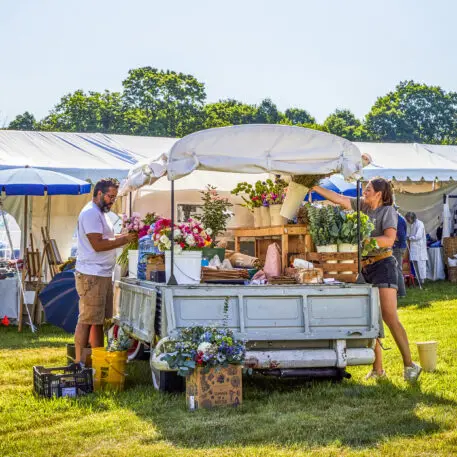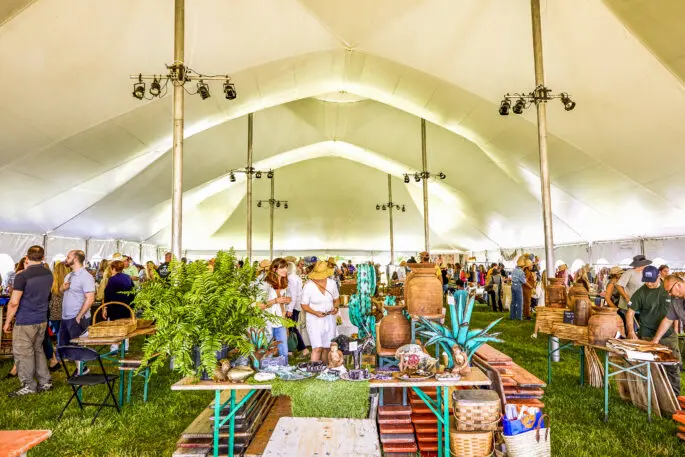There are plenty of benefits to shopping in the digital world, where the friction to consume is so low. But conversation and personality aren’t two of them. In the early days of the pandemic, Sue-Jean Kang found herself reflecting on those missing qualities. “Like everyone else, I was buying everything my family needed online. But all the while, I was thinking about the day when we would want to put down our phones and shop together for pleasure. Not survival. And that we might want to do it outside, the old-fashioned way, like people are drawn to green markets,” she says.
Kang grew up on the grounds of the famous Elephant’s Trunk Flea Market in New Milford, Connecticut, where her parents sold jewelry and sunglasses in the 80s, and a decade ago, Kang cofounded, operated, and eventually sold to new management what was once the largest artisanal food festival in the Mid-Atlantic region, called The Emporiyum at the time of the sale.
In the fall of 2020, Kang began planning a tented outdoor fair inspired by the European brocante, or flea markets, where strollers shop for “treasures,” whatever that might look like to them. She recognized the growing number of new city transplants now living full time in the southern New York state/Connecticut area, some of whom bought homes sight unseen, and knew when the COVID-19 clouds receded, it was only natural they would want to explore their new surroundings.
Her plan for Fine Day Fair, offering what she calls a mix of “heirlooms new and old,” would be an intersection of commerce and community for these newcomers, as well as attracting longtime New Englanders accustomed to seasonal countryside craft fairs.
Between her first live fair at Lasdon Park and Arboretum in Katonah, New York, in June of 2022 and her second in Onatru Farm Park, South Salem, NY later that year in November, Fine Day Fair showed a 338% net increase vendor revenue. (A third fair will be held at Onatru Farm Park on June 3 and 4.)
“We initially started out offering a higher price VIP, early access ticket for $40 and quickly realized less is more,” she says. “Other people were more receptive to a flat $20 entry fee and wanted their ticket to be acceptable throughout the weekend. So, we honored that.” The result was a 35% increase in ticket sales.

Authenticity and connection
Fine Day Fair brings together many elements of new consumerism embodied by shoppers with growing interest in the importance of process, from the traceable evolution of production to material sourcing practices. These maker-conscious consumers not only want excellent workmanship, but they also want to invest their dollars in the preservation of heritage crafts, searching out handmade or tiny batch goods that are relatively unbranded, often marked by locality.
In general, the way something is made (or manufactured) is related to the way it is sold (the nature of the money exchange). Mass-produced items are typically bought through an anonymous exchange (digitally or in-store through the escalating big-box practice of self-checkout), while something artisan-made or limited production might be bought at its source, maybe even directly from the craftsman in a personal, almost intimate act. You may tap your phone to pay at Fine Day Fair, but there is still conversation, creating value that increases both the perceived worth of the goods as well as the pleasure potential for both buyers and sellers.
“Within our first year, we quickly became one of the most successful craft, home, and garden shows in the area,” Kang says. “Our highest grossing vendors earn close to $18,000 in two days’ time, after paying a participation fee that is less than 2.5% of their actual earnings.”
Most of the vendors Kang features cannot afford a retail space—especially in this affluent area, where rent runs close to $90 to $100 per square foot— and many do not care to sell through a huge platform like Etsy. They more and more rely on fairs like Fine Day for in-place selling, going to great lengths to merchandise their 12×12 footprint.
Despite the small size, the vendor’s goal is to create an atmospheric showcase with display verticality by using repurposed objects like orchard ladders and a welcoming, layered look, often with vintage garden tables or slabs of barn wood offset by worn Oriental carpets. “When you are selling static goods, it’s important to bring in live elements, like fresh flowers and plants,” says Kang. “This is where bartering between vendors often happens. They are in touch ahead of time, pre-ordering supplies from our garden sellers.”
According to ACT Insurance (Artists, Crafters & Tradesman Insurance), the need for short-term vendor insurance is greater than ever, with 38% year-over-year growth between 2021 and 2022, and another 13% increase thus far in 2023.

Extensive curation
Like any retail store curator, Kang puts heavy emphasis on a vetting process to ensure that vendors have the goods she believes attendees want to buy. “To date, we have received thousands of vendors inquiries only to accept 3% of them,” she says. The process begins with a digital audit by Kang, who reviews the vendor’s website and Instagram to evaluate the way the goods look. She then conducts a physical audit, ordering samples so she can experience the products in real life. “I also consider the variety and range of their product line, making sure they offer smaller pieces,” Kang says. “There should always be a little something for attendees to buy, just to take a bit of the fair experience home with them.”
Kang’s skilled curation works on both sides of the made-sold equation. She provides vendors with a one sheet, breaking down the Fine Day Fair consumer into sales potential brackets. To attract and inform prospective consumers, Kang delivers the flavor of the fair via a website and through social media, spotlighting individual vendors as well as the range of product categories, and creates a sense of place with images of past fairs.
Kang says what Fine Day Fair really offers is a boundless supply of “surprise and delight,” which makes it readily scalable. “I am preparing to produce Fine Day Fair in other regions, and already have a long list of vendors ready to scale with me, those who are not trying to fit into a commercial lease, yet not wanting to detach themselves completely by relying solely on e-commerce,” she says. “In search of a more organic customer relationship, they are moving away from conventional retail in favor of live sales productions, delivering artisan goods to shoppers looking for authenticity.”
Francine Maroukian, two-time James Beard Award winner, is a former food and travel writer-turned-commercial-pragmatist who now works as an operative researcher for C-suite executives in big retail.
Recognize your brand’s excellence by applying to this year’s Brands That Matter Awards before the early-rate deadline, May 3.
